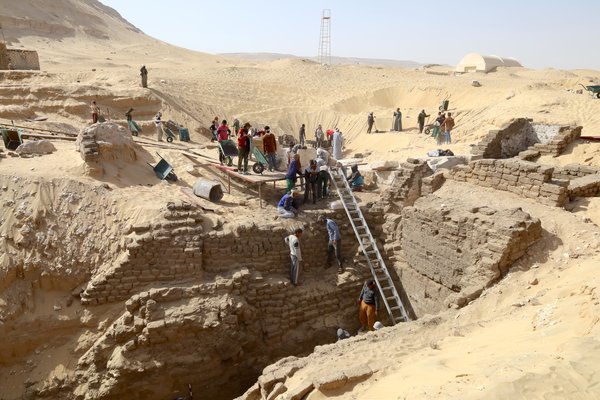Archaeologists in Egypt recently found the tomb of an unknown pharaoh who ruled during a turbulent period about 3,600 years ago, the Penn Museum said Thursday.
Penn researchers and Egyptian archaeologists made the discovery in January at Abydos, a sacred city near the west banks of the Nile River, several hundred miles south of Cairo. The limestone burial chamber was uncovered 23 feet underground in a desert, offering new insight into a lesser-known era when ancient Egypt was divided into a series of small dynasties.
MORE: Wild turkey on solo 'adventure' captures curiosity of Fishtown residents
The tomb is believed to have been built during Egypt's Second Intermediate Period from 1640-1540 B.C.E, about 1,000 years after the famed pyramids of Giza were constructed outside Cairo. The Second Intermediate Period came just before the New Kingdom, which is considered the most prosperous time for the ancient Egyptian empire, including King Tut's brief reign from 1332-1323 B.C.E.
When the mysterious tomb in Abydos was built, Egypt's warring dynasties were mired in political and economic upheaval. Rival invasions into Abydos left many of its artifacts vulnerable to theft by raiders, and scholars have had difficulty piecing together the succession of pharaohs from the Abydos dynasty.
Penn Museum curator Josef Wegner, who helped make the discovery in January, has been part of a yearslong collaboration with Egypt's Ministry of Tourism and Antiquities to unearth new details about the Abydos dynasty. Wegner and his colleagues led an excavation in 2014 that revealed the ancient tomb of King Senebkay, another Abydos dynasty ruler.
The tomb found in January, much larger than the previous discovery, has similar architecture and decorations that suggest it was built for a pharaoh who may have ruled some time before King Senebkay. The name of the unknown king was once written in hieroglyphic texts that adorned the bricks at the entrance to the tomb, but identifying features have not withstood the passage of centuries.
"Ancient tomb robbers damaged the hieroglyphic texts, and not enough survives to read the king's name," Wegner, who teaches Egyptian archeology at the University of Pennsylvania, said in a release about the discovery. "There are several possible owners for the new tomb, including two kings named Senaiib and Paentjeni who dedicated monuments at Abydos but whose tombs remain unknown."
Abydos is viewed as a sacred city and a preferred burial ground for pharaohs. Wegner believes the tomb found in January confirms there are other kings' tombs scattered in the desert that surrounds the Anubis Mountain. The tomb of King Senebkay is now a monument open to visitors, and Wegner hopes more sites will open up to help researchers develop a better chronology of the era.
"This discovery is a new window to understanding the origins of the enigmatic Abydos Dynasty," Wegner said.
The tomb in Abydos is one of two significant ancient Egyptian discoveries made in January. French and Swiss archeologists excavating in Saqqara, about 330 miles north of Abydos, uncovered the burial chamber of a prominent royal doctor who served ancient Egyptian kings about 4,000 years ago.
Wegner and his colleagues plan to continue excavating this year in the desert around Anubis Mountain, where they hope to find new burial sites and conserve the structures that have already been unearthed.

